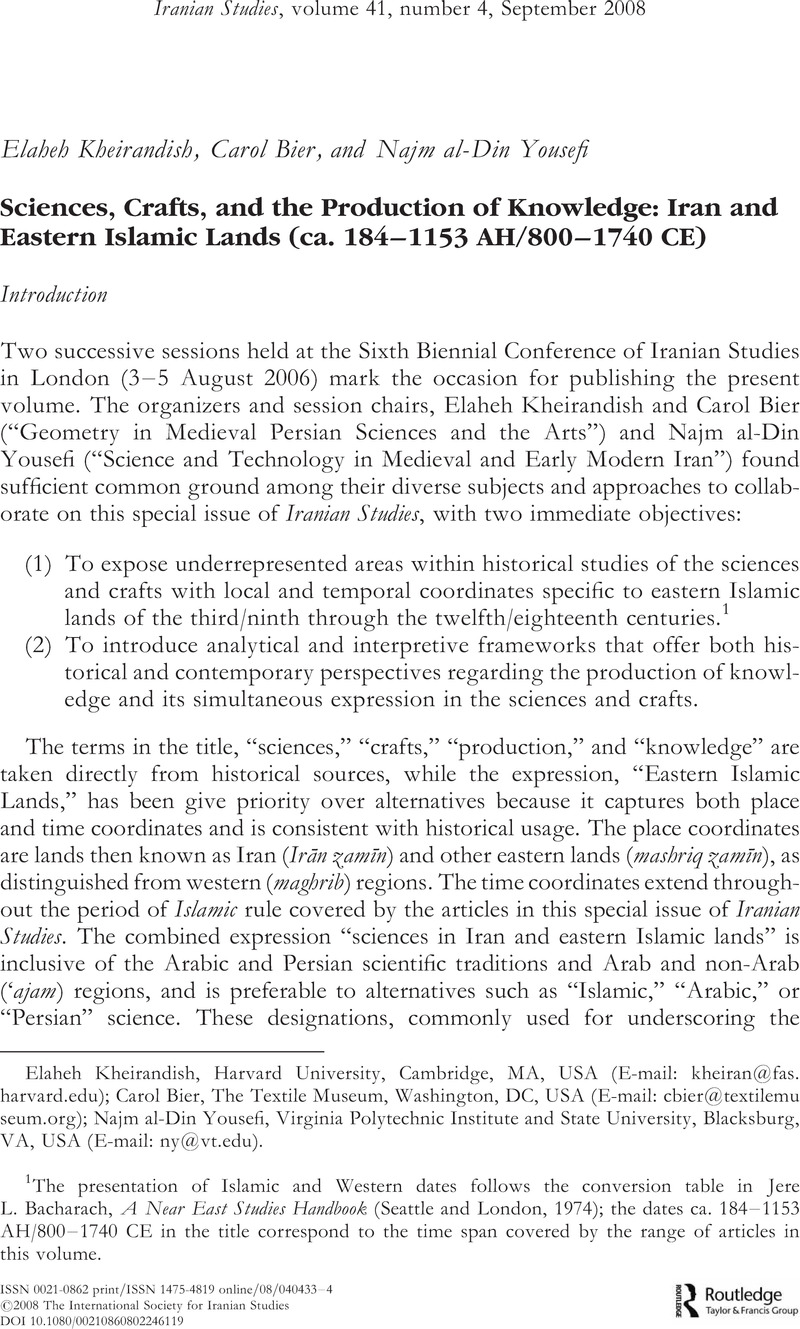No CrossRef data available.
Article contents
Sciences, Crafts, and the Production of Knowledge: Iran and Eastern Islamic Lands (ca. 184–1153 AH/800–1740 CE)
Published online by Cambridge University Press: 01 January 2022
Abstract

- Type
- Articles
- Information
- Iranian Studies , Volume 41 , Issue 4: Sciences, Crafts, and the Production of Knowledge: Iran and Eastern Islamic Lands (ca. 184–1153 AH/800–1740 CE) , September 2008 , pp. 433 - 436
- Copyright
- Copyright © Association For Iranian Studies, Inc 2008
References
1 The presentation of Islamic and Western dates follows the conversion table in Bacharach, Jere L., A Near East Studies Handbook (Seattle and London, 1974)Google Scholar; the dates ca. 184–1153 AH/800–1740 CE in the title correspond to the time span covered by the range of articles in this volume.
2 On the importance of early Islamic state and the contributions of non-Muslims, see Gutas, Dimitri, Greek Thought, Arabic Culture: The Graeco-Arabic Translation Movement in Baghdad and Early ‘Abbasid Society (2nd–4th/8th–10th centuries) (London, 1998)CrossRefGoogle Scholar; on the primacy of Arabic language and relevance of local contexts, see Sabra, A. I., “Situating Arabic Science: Locality versus Essence,” Isis, 87 (1996): 654–670CrossRefGoogle Scholar; on the role of Persian institutions, and the linguistic, ethnic, and thematic dimensions of the expression, “Persian” science, see Saliba, George, “Persian Scientists in the Islamic World: Astronomy from Maragha to Samarqand,” The Persian Presence in the Islamic World, ed. by Hovannisian, Richard G. and Sabagh, George (Cambridge, 1998), 126–146Google Scholar; the historical forms appear in plural as “ancient/recent sciences” (‘ulūm al-awā’il/al-muta'akhkhir), or mathematical/natural sciences (‘ulūm).
3 For Qus![]() ā Ibn Lūqā, see Kheirandish's, Elaheh entry under that name in the Biographical Encyclopedia of Astronomers (BEA) (New York, 2007), 2: 948–949Google Scholar, and BEA online; for the text, see Kheirandish, Elaheh, “Organizing Scientific Knowledge,” Organizing Knowledge: Encyclopaedic Activities in the Pre-Eighteenth Century Muslim World, ed. by Endress, Gerhard (Leiden, 2006), 135–154Google Scholar, esp. 149–150; the discussion of crafts is transmitted as part of a “discourse” titled Min kalām Qus
ā Ibn Lūqā, see Kheirandish's, Elaheh entry under that name in the Biographical Encyclopedia of Astronomers (BEA) (New York, 2007), 2: 948–949Google Scholar, and BEA online; for the text, see Kheirandish, Elaheh, “Organizing Scientific Knowledge,” Organizing Knowledge: Encyclopaedic Activities in the Pre-Eighteenth Century Muslim World, ed. by Endress, Gerhard (Leiden, 2006), 135–154Google Scholar, esp. 149–150; the discussion of crafts is transmitted as part of a “discourse” titled Min kalām Qus![]() ā ibn Lūqā, published by Daiber, Hand with a German translation: “Qosta ibn Luqa (9. Jh.) über die Einteilung der Wissenschaften,” Zeitschrift für Geschichte der arabischislamischen Wissenschaften, 6 (1990): 93–129Google Scholar.
ā ibn Lūqā, published by Daiber, Hand with a German translation: “Qosta ibn Luqa (9. Jh.) über die Einteilung der Wissenschaften,” Zeitschrift für Geschichte der arabischislamischen Wissenschaften, 6 (1990): 93–129Google Scholar.
4 On titles such as Fi al-‘amal bi al-kura al-nujūmīyya, or Fi al-‘amal bi al-as![]() urlāb al-kurī, and their respective interpretations as “On the Use of the Celestial Globe” or “On the Use of the Spherical Astrolabe,” see entries on Qus
urlāb al-kurī, and their respective interpretations as “On the Use of the Celestial Globe” or “On the Use of the Spherical Astrolabe,” see entries on Qus![]() ā Ibn Lūqā in the Biographical Encyclopedia of Astronomers (BEA) and Dictionary of Scientific Biography (DSB) respectively; on monument inscriptions, see Blair, Sheila S., Islamic Inscriptions (New York, 1998)Google Scholar, passim.
ā Ibn Lūqā in the Biographical Encyclopedia of Astronomers (BEA) and Dictionary of Scientific Biography (DSB) respectively; on monument inscriptions, see Blair, Sheila S., Islamic Inscriptions (New York, 1998)Google Scholar, passim.
5 al-Fārābī, Abū Naṣr, I![]()
![]() ā' al-‘ulūm, ed. by Amine, O. (Cairo, 1968), 93–110, esp. 93–110Google Scholar; Arabic edition from Escorial manuscript by A. González Palencia, Alfarabi Catálogo de las sciencias (ACLS), includes medieval Latin and modern Spanish translation (Madrid, 1932, 1953); for references to passages and translations, see Kheirandish, “Organizing Scientific Knowledge,” as well as her contribution in the present volume.
ā' al-‘ulūm, ed. by Amine, O. (Cairo, 1968), 93–110, esp. 93–110Google Scholar; Arabic edition from Escorial manuscript by A. González Palencia, Alfarabi Catálogo de las sciencias (ACLS), includes medieval Latin and modern Spanish translation (Madrid, 1932, 1953); for references to passages and translations, see Kheirandish, “Organizing Scientific Knowledge,” as well as her contribution in the present volume.
6 al-Ṣafā’, Ikhwān, Rasā’il, ed. by Tamir, A., 5 vols. (Beirut, 1994), 1: 123, 269–284Google Scholar.
7 A concise summary of this subject as treated by the Ikhwān is offered by Akkach, Samer, Cosmology and Architecture in Premodern Islam: An Architectural Reading of Mystical Ideas (Albany, 2005), 36–37Google Scholar and 45–46.
8 See respectively Mahdi, Muhsin, Ibn Khaldun's Philosophy of History (Chicago, 1964), 222Google Scholar; Khaldūn, Ibn, The Muqaddimah: An Introduction to History, trans. by Rosenthal, Franz (Princeton, 1967), 378Google Scholar; Arabic original: A. Wafi (Paris, 1960), 3: 949; see also Bier, Carol, “Patterns in Time and Space: Technologies of Transfer and the Cultural Transmission of Mathematical Knowledge across the Indian Ocean,” Ars Orientalis, 34 (2007): 174–196Google Scholar.
9 Mahdi, Ibn Khaldun's Philosophy of History, 222.
10 Afshar, Iraj, “La notion de ‘sciences appliquées’ dans les texts classiques persan,” Les sciences dans le monde iranien, ed. by Vesel, Z., Beikbaghban, H. and Thierry de Crussol des Epesse, B. (Actes du Colloque Strasbourg, 1995)(Tehran, 1998), 155–164Google Scholar.




